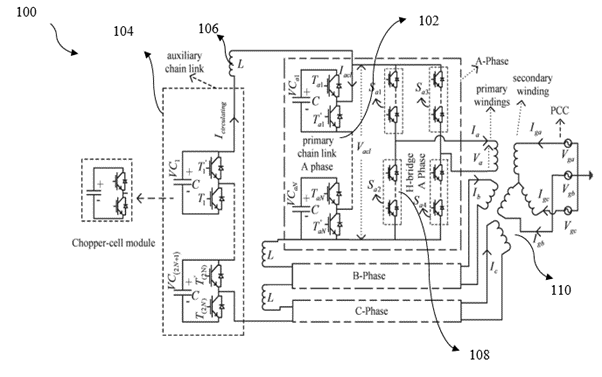This invention provides a Delta Hybrid Modular Multilevel Converter (DHMMC). The DHMMC comprises of at least three primary chain-links and an auxiliary chain-link. Each of the at least three primary chain-links and the auxiliary chain-link are inter-connected through at least one inductor to form a delta configuration, and each of the at least three primary chain-links and the auxiliary chain-link comprises a predefined number of chopper cell modules. The DHMMC further comprises at least three bridge modules configured to receive output from the predefined number of chopper cell modules in each of the at least three primary chain-links and at least three single-phase transformers configured to receive output from the at least three bridge modules. Preselected windings of the at least three single-phase transformers are connected in a predefined manner to feed ac grid in the DHMMC.
The increasing penetration of non-linear unbalanced loads and energy sources into the grid, such as industrial loads and renewable energy sources, the power quality of the power system is continuously degrading. Reactive power support from different sources and converters such as Static Compensators (STATCOMS) can solve the power quality problems.
The Parallel Hybrid Modular Multilevel Converter (PHMMC) used for HVDC application applications has less sub-modules, switching devices compared to Modular Multilevel Converters (MMC). However, it is characterized to operate at a fixed modulation index. To control the flow of reactive power between the converter and grid, the output voltage of the PHMMC needs to be regulated and this is possible only if the modulation index of the converter is controllable. The ability to regulate the modulation index of PHMMC is achieved through Third Harmonic Voltage Injection Method (THIM). By injecting same quantity of third harmonic voltage component in all the three chain-links of the PHMMC, control over the modulation index is attained but the range of control over the modulation index still remains limited. During unbalanced conditions, the capacitor voltage of the chain-links tend to divert from their reference values due to uneven exchange of power from the chain-links with the grid. The capacitor voltages are restored back to their reference value by injecting unequal quantities of third harmonic voltage in the three chain-links. The disadvantage is that the injected unequal third harmonic components may appear in the line-line voltage of the grid thus injecting harmonics into grid. Also, with the injection of the unequal third harmonic voltage, the PHMMC can handle limited degree of unbalance in the grid voltage as presented in literature.
- This innovation proposes a new Hybrid Modular Multilevel Converter (HMMC) converter which is named as Delta-HMMC-STATCOM (DHMMC) as shown in Figure 1.
- The proposed DHMMC has lower number of energy storing devices, smaller capacitance size, and low switching losses compared to MMC.
- The proposed DHMCC configuration has a provision for circulating current which can be controlled to balance the capacitor voltages of the chain-links when the converter is feeding an unbalanced network. Also, during unbalanced conditions, the capacitor voltages of the DHMMC can be regulated by injecting common mode voltage to the chain-links unlike the conventional Delta Cascade H-bridge configuration. Hence, the DHMMC has two degrees of freedom for regulating the capacitor voltages during unbalance.
- The proposed converter can operate in the full range of modulation index, since there is no fixed DC link.
- The auxiliary chain-link does not have any H-bridge associated with it nor does it feed any power to the grid, but still the auxiliary chain-link plays a vital role for forming the closed loop.
A prototype has been developed.
- The proposed innovation has been validated with simulations and theoretical analysis.
- Experimental results need to be analyzed to validate the operating principles.
This technology occupies less footprint and offers less cost. Hence, it is likely to consume less funds from the government (save tax payers money) in the installment process. It also improves power quality of the grid and hence, prevents emergency loads (such as medical equipment, military equipment).
- This technology is very much suitable for FACTS and high/medium voltage power system applications
- It is also useful for high voltage and medium voltage applications, simple, easy to adopt, modular construction, energy storage required to generate an output of one MVA is less, lesser number of capacitors, lower capacitor size, lower switching losses, Zero Voltage Switching (ZVS soft switching) capability, can be applied to compensate unbalance in grid/load.
Geography of IP
Type of IP
202021016994
514158

